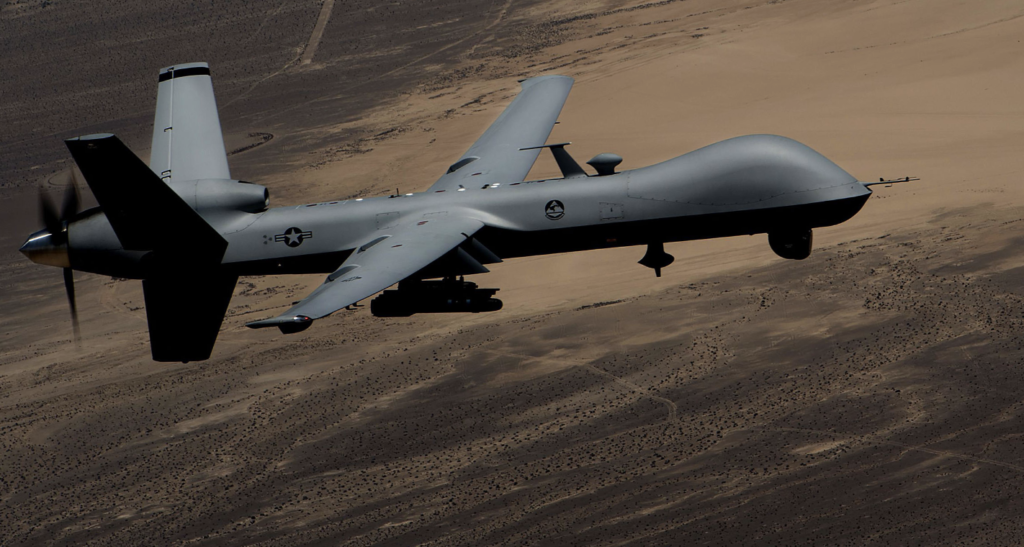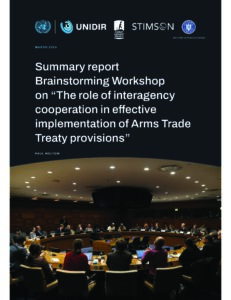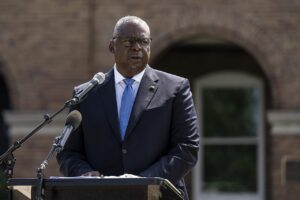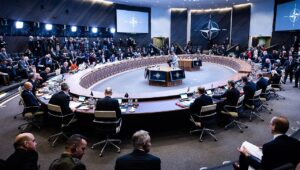Introduction
The September 11th attacks ushered in a new era of national security and foreign policy in the United States, in which the U.S. government prioritized counterterrorism and established as well as assumed broad policies and authorities for identifying and countering threats to the U.S. through the use of lethal force.1Assumed authorities noted here include, for example, the use of covert lethal action and Article II authorities under the U.S. Constitution to use force in self-defense. The U.S. government’s responses to the tragedy cast a long shadow on the ways in which the United States has since conceptualized and operationalized counterterrorism and the use of lethal force.
Since 9/11, the United States has shifted its posture from responding to the attacks to preventing terrorism through global policies designed to disrupt or deter threats using any means necessary. This policy shift has done more than shape military and intelligence activities for the last 20 years, it has also contributed to policies that have shielded these activities from public scrutiny, and stifled critical debates. In the process, the U.S. security apparatus grew, and U.S. lethal engagements abroad evolved into highly remote, expansive, and opaque operations. One of the most prominent yet secretive legacies of the post-9/11 security apparatus and a core component of the United States’ ongoing “forever wars” is the U.S. program for conducting lethal airstrikes outside war zones against people suspected of terrorism. And among the most notorious symbols for this program are U.S. armed drones.2In this context, the term war zone refers to traditional, territorially defined battlefields, often referred to as “areas of active hostilities.” Under the Obama administration, Afghanistan, Iraq, and Syria, as well as parts of Libya at times, were considered war zones or “areas of active hostilities.” Other countries where U.S. counterterrorism operations occurred – such as Pakistan, Somalia, and Yemen – were viewed as falling outside these areas. The Trump administration reportedly declared parts of Somalia and Yemen as “areas of active hostilities,” though it remains unclear if those declarations remain in place. For the purposes of this paper, “war zones” refers to Afghanistan, Iraq, and Syria – though it is worth considering whether these theaters currently reflect active war zones as they did four years ago.
Since 2013, the Stimson Center has researched the ways in which drone strikes facilitated the evolution of U.S. lethal engagements abroad, and analyzed the risks and challenges posed by the U.S. government’s dependence on armed drones and lethal airstrikes as principal tools for counterterrorism. This report builds on that body of work and examines the consequences of the United States’ permissive use of lethal force around the world – often exhibited by airstrikes.
The U.S. program of lethal airstrikes outside of recognized war zones both defines and symbolizes the United States’ war-based approach to counterterrorism. Sustained by three administrations, the program is a key area of concern because it helped establish and normalize a tactic of targeting individuals on the basis of short-term considerations while overlooking broader strategic concerns and considerations. Once confined to a few countries and targets, the normalization of the program has enabled the secret, unaccountable use of force to spread to new geographies and a growing array of targets who have little to no formal association with the architects of 9/11. Indeed, the U.S. program of lethal airstrikes largely operates in the shadows, targets a shifting set of adversaries, evades proper oversight, perpetuates considerable harm, minimizes accountability, and has no discernible endgame.3Scott Roehm, Rita Siemion, and Hina Shamsi, “Toward a New Approach to National and Human Security: Introduction,” Just Security, September 11, 2020, https://www.justsecurity.org/72359/toward-a-new-approach-to-national-and-human-security-introduction/; Rita Siemion, Hina Shamsi, Daniel R. Mahanty, Heather Brandon-Smith, Priyanka Motaparthy, and Matt Hawthorne, “Toward a New Approach to National and Human Security: End Unlawful, Secret, and Unaccountable Use of Lethal Force,” Just Security, September 11, 2020, https://www.justsecurity.org/72375/toward-a-new-approach-to-national-and-human-security-end-unlawful-secret-and-unaccountable-use-of-lethal-force/; Rita Siemion, Scott Roehm, Hina Shamsi, Heather Brandon-Smith, Kate Kizer, Annie Shiel, Colleen Kelly, and Mandy Smithberger, “Toward a New Approach to National and Human Security: End Endless War,” Just Security, September 11, 2020, https://www.justsecurity.org/72371/toward-a-new-approach-to-national-and-human-security-ending-endless-war/. The program has greatly hindered independent assessments of the impact, legitimacy, and strategic efficacy of such lethal operations for more than 10 years.
The upcoming 20th anniversary of the 9/11 attacks – paired with the recent transition to a new U.S. presidential administration and the historic and tumultuous events of 2020 – presents an opportune time to reevaluate the polices of the last 20 years. The Biden administration should reflect on the ways in which the post-9/11 U.S. security state has transformed U.S. engagement in the world and reassess the U.S. approach to lethal force to restore the principles and values that drive U.S. foreign policy.
There is an opportunity to accept a bolder vision for how we understand and interpret U.S. national security and to change course, to not only reconsider the United States’ approach, but account for the harm wrought by the prevailing narratives that have guided U.S. policies and actions for a generation.4Luke Hartig, “On 9/11, Interrogating the Assumptions that Undergird the ‘Forever War’,” Just Security, September 11, 2020, https://www.justsecurity.org/72393/on-9-11-interrogating-the-assumptions-that-undergird-the-forever-war/. The last 20 years of military and counterterrorism engagement have demonstrated the perils of prevention-based policies, which have focused almost exclusively on anticipation and prevention and have left no room for policies focused on resiliency and rights-promoting responses.5Dan Mahanty, “Renovating ‘the Swamp’ post COVID-19 by reconfiguring budgets and bureaucracy,” Responsible Statecraft, April 8, 2020, https://responsiblestatecraft.org/2020/04/08/renovating-the-swamp-post-covid-19-by-reconfiguring-budgets-and-bureaucracy/.
This report reflects on the current status of the U.S. program of lethal airstrikes outside war zones – or what the U.S. government refers to as “areas of active hostilities” – and critically examines the narratives used to rationalize U.S. lethal activities abroad and perpetuate America’s “endless wars.” The report concludes with a series of recommendations for advancing appropriate and responsible U.S. policies guiding the use of force and better aligning U.S. actions with U.S. principles in 2021 and beyond.
Trailer
Notes
- 1Assumed authorities noted here include, for example, the use of covert lethal action and Article II authorities under the U.S. Constitution to use force in self-defense.
- 2In this context, the term war zone refers to traditional, territorially defined battlefields, often referred to as “areas of active hostilities.” Under the Obama administration, Afghanistan, Iraq, and Syria, as well as parts of Libya at times, were considered war zones or “areas of active hostilities.” Other countries where U.S. counterterrorism operations occurred – such as Pakistan, Somalia, and Yemen – were viewed as falling outside these areas. The Trump administration reportedly declared parts of Somalia and Yemen as “areas of active hostilities,” though it remains unclear if those declarations remain in place. For the purposes of this paper, “war zones” refers to Afghanistan, Iraq, and Syria – though it is worth considering whether these theaters currently reflect active war zones as they did four years ago.
- 3Scott Roehm, Rita Siemion, and Hina Shamsi, “Toward a New Approach to National and Human Security: Introduction,” Just Security, September 11, 2020, https://www.justsecurity.org/72359/toward-a-new-approach-to-national-and-human-security-introduction/; Rita Siemion, Hina Shamsi, Daniel R. Mahanty, Heather Brandon-Smith, Priyanka Motaparthy, and Matt Hawthorne, “Toward a New Approach to National and Human Security: End Unlawful, Secret, and Unaccountable Use of Lethal Force,” Just Security, September 11, 2020, https://www.justsecurity.org/72375/toward-a-new-approach-to-national-and-human-security-end-unlawful-secret-and-unaccountable-use-of-lethal-force/; Rita Siemion, Scott Roehm, Hina Shamsi, Heather Brandon-Smith, Kate Kizer, Annie Shiel, Colleen Kelly, and Mandy Smithberger, “Toward a New Approach to National and Human Security: End Endless War,” Just Security, September 11, 2020, https://www.justsecurity.org/72371/toward-a-new-approach-to-national-and-human-security-ending-endless-war/.
- 4Luke Hartig, “On 9/11, Interrogating the Assumptions that Undergird the ‘Forever War’,” Just Security, September 11, 2020, https://www.justsecurity.org/72393/on-9-11-interrogating-the-assumptions-that-undergird-the-forever-war/.
- 5Dan Mahanty, “Renovating ‘the Swamp’ post COVID-19 by reconfiguring budgets and bureaucracy,” Responsible Statecraft, April 8, 2020, https://responsiblestatecraft.org/2020/04/08/renovating-the-swamp-post-covid-19-by-reconfiguring-budgets-and-bureaucracy/.




